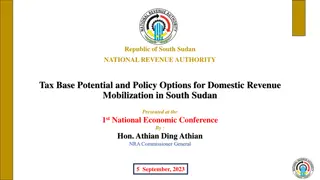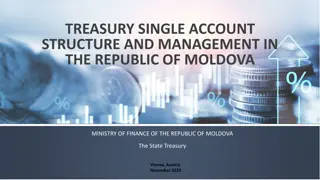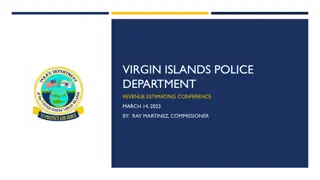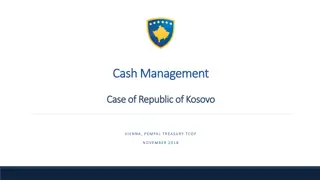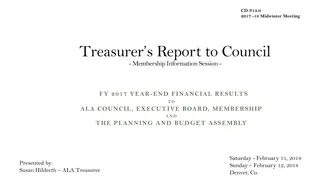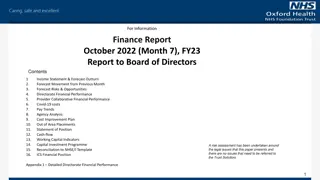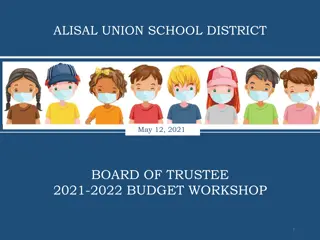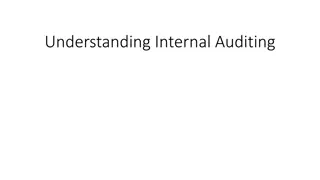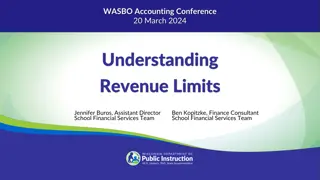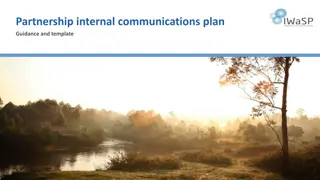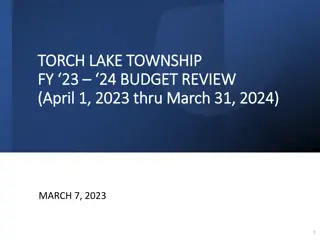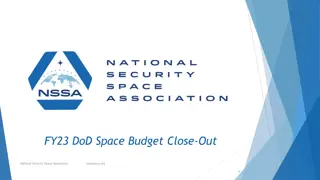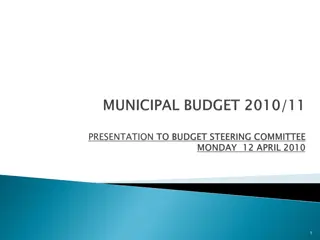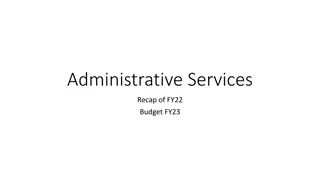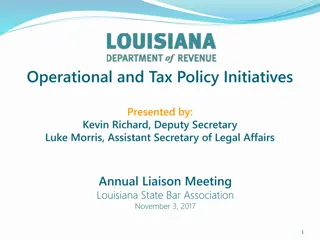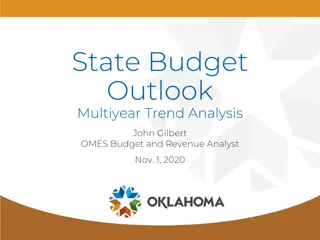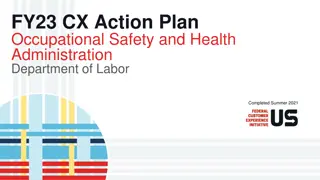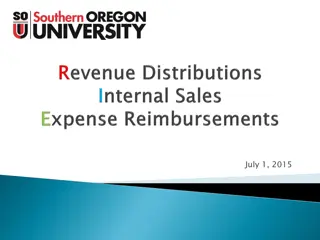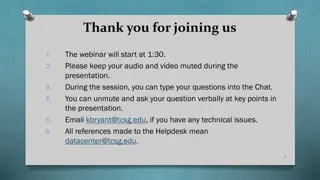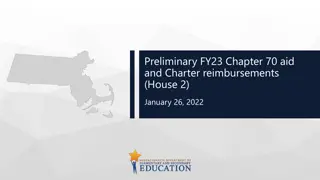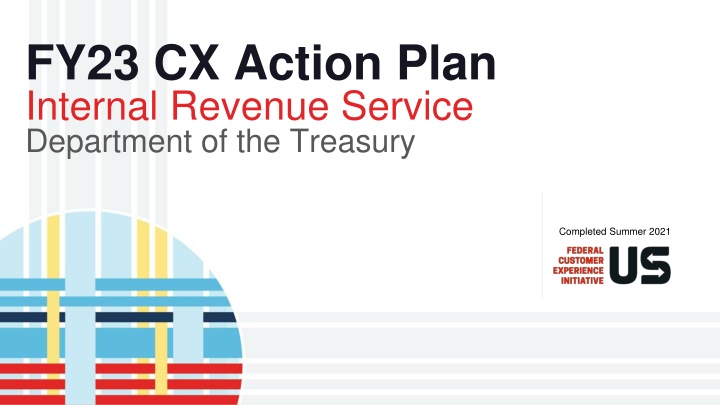
FY23 CX Action Plan Internal Revenue Service Department of the Treasury Completed Summer 2021
In FY23, the Internal Revenue Service Department of the Treasury completed their action plan, focusing on enhancing the taxpayer experience through innovative approaches, organizational updates, and training strategies. Key achievements include the establishment of a Chief Taxpayer Experience Officer and expanding services like Customer Callback, Form 1040X electronic filing, and multilingual support. The IRS is dedicated to improving end-to-end taxpayer experience across various segments and has developed a tiered framework to measure the success of their strategy.
Download Presentation

Please find below an Image/Link to download the presentation.
The content on the website is provided AS IS for your information and personal use only. It may not be sold, licensed, or shared on other websites without obtaining consent from the author. If you encounter any issues during the download, it is possible that the publisher has removed the file from their server.
You are allowed to download the files provided on this website for personal or commercial use, subject to the condition that they are used lawfully. All files are the property of their respective owners.
The content on the website is provided AS IS for your information and personal use only. It may not be sold, licensed, or shared on other websites without obtaining consent from the author.
E N D
Presentation Transcript
FY23 CX Action Plan Internal Revenue Service Department of the Treasury Completed Summer 2021
FY21 Capacity Assessment Reflection Summary What we re proud of this year: Through continuous engagement with a wide range of taxpayers, taxpayer representatives, tax professionals, employees, and other stakeholders including private industry we developed a comprehensive taxpayer experience strategy, proposal to update the IRS organizational structure, and comprehensive training strategy. These efforts give us an incredible opportunity to make significant improvements across our operations by developing innovative approaches to the future of tax administration. This was a focal point for the IRS in FY 2021. In FY 2021, we established a Chief Taxpayer Experience Officer, a direct report to the IRS Commissioner, to lead an office of experts in the areas of customer experience, research, behavioral analytics, human-centered design, and service delivery with the ability to provide other organizational units with information on changing taxpayer expectations, industry trends, and ways to apply customer service best practices within the framework of IRS operations and federal limitations. In FY 2020, we finished our second successful year of offering Customer Callback (CCB) service and expanded CCB from one application to five toll-free applications and offered CCB service to 1.22 million taxpayers. Of these, nearly 835,000 callers accepted the CCB option, representing a 68 percent acceptance (take rate), about 10 percentage points above industry averages. In total, CCB achieved a successful re-connection rate to a customer service representative of nearly 90 percent and saved taxpayers 486,000 hours of live hold time by allowing them to leave a callback number, disconnect and await their reconnect. In FY 2021, we expanded customer callback from five applications to 16, meaning that over 40% of our toll-free demand is provisioned to support customer callback. We plan to continue expanding callback with a goal of 95% of our demand provisioned for callback by FY 2024. In FY 2020 we began accepting Form 1040X (Amended Returns) electronically a long-time goal, and significant experience improvement, that allows taxpayers to file their amended tax returns faster while minimizing errors, and we plan to make further enhancements to improve processing and expand direct deposit capability. In FY 2020, we enhanced Taxpayer Digital Communications with a new online chat feature for taxpayers and their authorized representatives to securely interact with designated IRS revenue agents and tax examiners. In FY 2021, we converted 11 highest volume notices to a digital format and viewable through our Online Account application. In FY 2020/2021 we made great progress in our efforts to expand ways to communicate to taxpayers who prefer to get information in other languages: IRS expands help to taxpayers in multiple languages with new forms, communication preferences | Internal Revenue Service Taxpayer feedback and research indicated our current authentication process can be challenging because it relies on financial information. In response to this feedback, in FY 2021, we piloted an improved authentication service that is designed to enhance the taxpayer experience by increasing authentication rates for our digital services. 2 Where we need to do better: Service has always been an area of focus for the IRS, with program leadership dedicated to specific segments of the customer experience strategy; however, an end-to-end, multi-channel view of taxpayer experience across these segments is an area we need to continue to improve. The establishment of the Taxpayer Experience Office is intended to bridge these segments and bring a wholistic approach to the way we improve, monitor, and measure the taxpayer experience, as well as the success of the taxpayer experience strategy. To measure the success of the taxpayer experience strategy, we developed a tiered framework which includes Access measures, Adoption measures, and Impact measures. This framework will allow us to track the effectiveness of the strategy.
Adapting Service During a Global Pandemic Where we innovated During the COVID-19 pandemic, the IRS was called upon to quickly deliver three rounds of Economic Impact Payments (EIP) to millions of Americans. In a bit more than 14 months, IRS and Treasury employees delivered more than $800 billion through more than 474 million payments, as of June 8, 2021. To quickly deliver EIPs and provide information to eligible recipients, the IRS provided two new online tools in record time. The Get My Payment tool, which launched on IRS.gov on April 15, 2020, and is available in English and Spanish, allows many taxpayers to check the status of their payment or enter their bank account information to receive their payment electronically, Since the launch of Get My Payment, nearly 350 million successful status checks have been made using this tool. And nearly 15 million people have successfully provided their banking information, meaning they received their payments much more quickly via direct deposit. The Non-Filers tool, which was launched on IRS.gov on April 10, 2020, and available through November 21, 2020, in both English and Spanish, allowed people who normally don t have a filing obligation to enter basic information so that they could receive their payment. Of the more than 8.5 million claims received by non-filers, nearly 7.9 million were filed using the Non-Filers tool. To proactively reach many who don t normally have a tax filing requirement, we deepened our partnerships with other Federal Agencies. We worked cooperatively with the Social Security Administration (SSA), Veterans Affairs (VA), and other government agencies to pull these agencies information into our systems to ensure that we could send payments to these groups of people without requiring them to file a return or take any other action. These agencies provided critical help that allowed the IRS to reduce the burden for these individuals, including reducing the need for them to seek in-person tax return preparation to file a return. This effort was a significant step beyond anything the IRS was able to do during previous stimulus efforts. To improve the experience, we also proactively distributed supplemental payments for people who received EIP payments based on their 2019 tax returns but were eligible for a new or larger payment based on their processed 2020 tax returns. And we took steps to automatically refund money to people who filed their tax return reporting unemployment compensation before the changes made by the American Rescue Plan. We also extended our reach far beyond our normal contacts to many lower-income, military, veterans, retired, older, limited English proficient, and homeless communities around the country. We worked with our partners to distribute EIP outreach materials in 35 languages within these communities. Our innovative and agile system development, expanded federal and private partnerships, and expanded outreach will be leveraged as the IRS is called upon to expand beyond our traditional role and provide benefits administration. For example, the IRS used the lessons learned during EIP to quickly develop and deploy three web applications to support the Advance Child Tax Credit in 2021. During the pandemic we also focused on digitizing forms and processes, expanded the use of electronic signatures, and quickly scaled up telework for thousands of employees, including over 11,000 call center customer service representatives. These efforts will position us to be more agile as we continue to deal with the pandemic and will enable us to be more flexible in future emergencies. 3
HISP Equity Reflection Who is this provider intended to serve? The IRS serves and interacts with more Americans than nearly any other public or private organization. This action plan focuses primarily on individual taxpayers and taxpayer-initiated service channels. Are there barriers that people of color, people with disabilities, LGBTQ+ people, women, non-native English speakers, and others who have been historically underserved, marginalized, discriminated, and adversely affected by persistent poverty and inequality face with regard to this program or service? How might these individuals interact with your program differently? We understand that some segments of the taxpayer population face unique obstacles to getting access to the information and services needed to comply with their tax obligations. A significant component of our Taxpayer Experience Strategy focuses on building on existing successes and establishing specific ways to engage with underserved communities. We are working with the Department of Treasury, the Office of Tax Policy, the Census Bureau, and OMB to develop research projects to provide more data and analysis related to these challenges. For example, Treasury and IRS are analyzing data on the impact of notices that were distributed to encourage potentially eligible individuals to apply for Economic Impact Payments to provide relief during the COVID-19 crisis. The goal of the analysis is to inform future outreach programs designed to encourage broad, timely access to benefit programs administered through the tax system. We must also continue to broaden workforce strategies for outreach to underrepresented communities to ensure our employees are reflective of the communities they serve. Where do we have a knowledge gap about individuals interactions with our service we need evidence to fill? [Note, there should be some data cited to back this up] Extensive outreach, research, and engagement with a wide range of employees, taxpayers, taxpayer representatives, tax professionals, and other stakeholders was conducted during development our Taxpayer Experience Strategy to address knowledge gaps. As a result, the strategy includes a focus area dedicated specifically to underserved communities and identifying opportunity areas for improvement. 4
HISP Equity Reflection (cont.) Where do we have a knowledge gap about individuals interactions with our service we need evidence to fill (Continued)? Our focused program for underserved communities will unify existing IRS efforts and involve our Community of Partners to further address issues of communication, education, transparency, trust, and limited access to high-quality products and services, including lack of access to digital resources. We need a focused approach as some segments of the taxpayer population face unique challenges in getting access to the information and services needed to comply with their tax obligations. Below are two areas outlined for improvement in our underserved strategies: Multilingual Strategy More than 20% of U.S. residents speak a language other than English at home. Of these approximately 66.6 million people, 26 million describe themselves as speaking English less than very well and are considered individuals with limited English proficiency. International Strategy Non-resident individuals and businesses with a connection to the United States have unique tax considerations and may have difficulty accessing IRS services. They tend to rely on IRS.gov as their main resource for information on U.S. filing requirements, taxable income, tax treaties, payments, etc. Yet, because they often lack U.S. financial accounts or have foreign addresses and international telephone numbers, these taxpayers are frequently unable to access online IRS services due to current identity proofing and authentication standards. Also, as of tax year 2017, only 48.4% of international individual taxpayers filed electronically, compared to 88.3% of domestic individual taxpayers. As a result, there is a tremendous opportunity to increase international taxpayer use of the IRS eFile program. 5
FY23 Commit to Action: Expand Digital Services What customer need will this action address? Expansion of digital services to align more closely with those provided by banks and other private sector organizations. Why is this a priority? Digital and online services continue to be an expectation for taxpayers and practitioners. The FY 2020 Taxpayer Experience Survey indicates that awareness of IRS.gov as a service channel continues to be high at 86%; and visits to IRS.gov increased significantly from 46% to 52% in 2020. Extensive research and engagement with a wide-range of stakeholders during development of the Taxpayer Experience Strategy also indicates the desire for digital services like those provided by banks and other private sector organizations. However, we continue to recognize the need to have non-digital options, such as phone, paper, and face-to-face, available. Who is responsible for this action happening? Expansion of digital services requires enterprise-wide participation and coordination. The Taxpayer Experience Office will serve as the bridge across the organization to develop a strategic roadmap for expansion of digital services as well as the other focus areas outlined in the Taxpayer Experience Strategy. What action(s) / deliverables / milestones will you take / hit between Oct. 1, 23 Sept. 30, 24? We will enhance the IRS s Online Account for individual taxpayers and expand this service to tax professionals. Additional authenticated online self-services will include account updates, secure messaging and notice delivery, full interaction history and issue status, expansion of digital payment options, increased electronic receipt of filings and scanning/data capture for paper filings, document upload, and more. Taxpayers will see expanded scope for e-signatures, secure document exchange and expanded payment options like Venmo and PayPal, and web chat and other digital assisted services. 6
FY23 Commit to Action: Expand Digital Services (cont.) How will you measure whether these actions had their intended effect? 7 What do you need to make this happen? Time and significant and timely multi-year funding for IRS implementation of the Taxpayer Experience Strategy, as well as the IRS Modernization Plan, will be required to fully realize the vision outlined in the Taxpayer Experience Strategy.
FY23 Commit to Action: Increase Service to the Underserved What customer need will this action address? Our strategies will continue to address issues of communication, education, transparency, trust, and access to quality products and services, including providing customized education and outreach in the languages spoken by specific taxpayer groups. Why is this a priority? [Note, there should be some data cited to back this up] We view our efforts through the eyes and experience of those we proudly serve. An important way the IRS serves taxpayers during the filing season and throughout the year is by communicating with them in their most comfortable language. According to our research, in 2020 71% of Limited English Proficient (LEP) taxpayers reported having contacted the IRS using at least one channel. This is significantly higher than among taxpayers overall (60%) and a marked increase from last year (58%). They were less likely than taxpayers in general to visit IRS.gov (46% vs. 52%) but significantly more likely to use the other IRS channels, including calling an IRS toll-free line (40% vs. 18%) and visiting a local office (30% vs. 7%). This underscores the importance of expanding language services in all channels to effectively serve our LEP population. Who is responsible for this action happening? Successfully expanding services to underserved communities will require enterprise-wide participation and coordination. The Taxpayer Experience Office will serve as the bridge across the organization to further develop and implement these strategies. What action(s) / deliverables / milestones will you take / hit between Oct. 1, 23 Sept. 30, 24? Translate Forms, Publications and Notices with Clarity and Accuracy: Increase the languages available for most widely used forms, publications and notices. Partnership Expansion: Build on existing partnerships, develop new partnerships, and leverage recent successes during Economic Impact Payments and Advance Child Tax Credit efforts to continue to innovate and reach underserved communities. Leverage Employee Multi-lingual Skills: Incentivize employees to be certified as multilingual and recruit these employees to provide multi-lingual assistance and services. Recruitment: Increase incentives for prospective bilingual / multilingual employees and specify the languages we are looking for during hiring. 8
FY23 Commit to Action: Increase Service to the Underserved (cont.) How will you measure whether these actions had their intended effect? 9 What do you need to make this happen? Time and significant and timely multi-year funding for IRS will be required to support these actions and fully realize the vision outlined in the Taxpayer Experience Strategy.
Commitments from Executive Order 14058 On December 13th, 2021 (after agencies originally developed these action plans as part of the FY23 budget formulation process), President Biden signed Executive Order 14058 on Transforming Federal Customer Experience and Service Delivery To Rebuild Trust in Government. Section 4 of this Order was developed by working with HISPs to identify specific improvements to their core services (many of which were proposed in their FY23 Action Plans), to lift up and energize their existing efforts, improving accountability and support. For IRS, EO 14058 commitments include: Design and deliver new online tools and services to ease the payment of taxes and provide the option to schedule customer support telephone call-backs. Consider whether such tools and services might include expanded automatic direct deposit refunds based on prior year tax returns, tax credit eligibility tools, and expanded electronic filing options. For more updates on agency progress on specific commitments, please visit https://www.performance.gov/cx/executive-order/.


